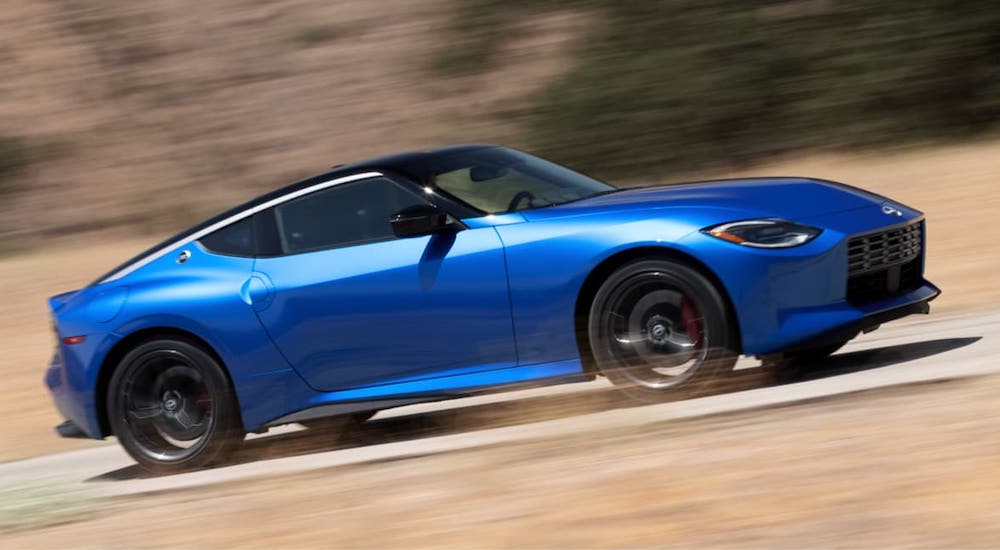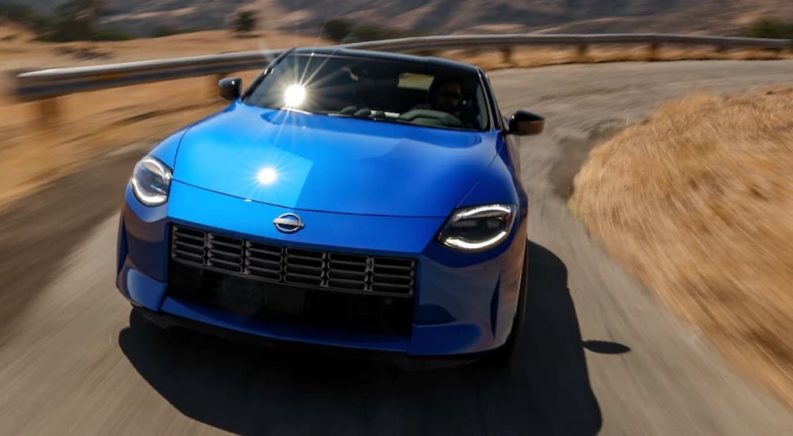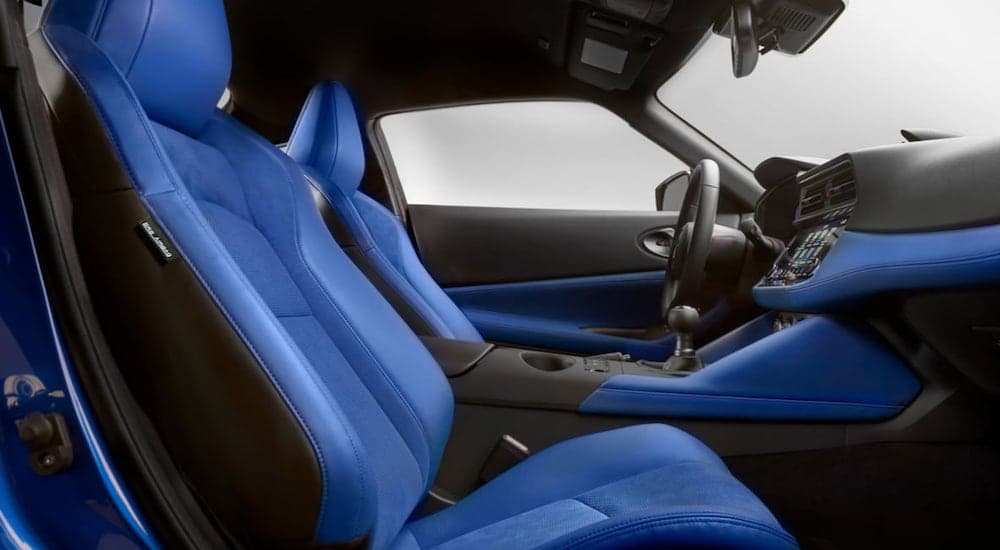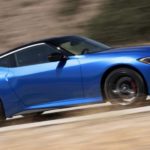When Nissan revealed the new 2023 Z in August of 2021, Z-car enthusiasts were glued to the streamed event that finally ripped the cover off the seventh generation of a well-loved sports car. Fans dedicated to Z culture were treated to a design that both paid homage to the last 50 years and incorporated futuristic elements for a unique new appeal. Unlike the far more expensive Nissan GT-R, the Z is a sports car built to be more accessible for a wider audience who enjoys cruising just for fun. The long-nosed, short rear deck body shape for the 2023 model recalls the iconic first-generation Z, while other design elements are plucked from generations between. In anticipation of the upcoming availability at your nearby Nissan dealer, let’s look at how the Z was developed.
Hidden Design Elements on the Outside
The exterior design of the 2023 Z incorporates a mixture of elements from past generations, but the designers paid careful attention to how the overall look would inspire a connection to the car. Nissan chose to pull elements of past models by carefully researching which aspects of past generations were successfully executed, taking into account the reaction of past owners’ interactions with the Z. Then, Nissan blended inspired artistic, cultural, and natural elements that brought the design to life. The result is a sleek front-engine, rear-wheel drive coupe that begs to be driven on winding curves.
Hidden design features like the Golden Ratio—also known as the Fibonacci Sequence—were utilized in an effort to connect with an onlooker’s eye through the natural spacing of features on the body. The spacing of door height in relation to the side mirror and shape of the door edge exemplifies the use of the Golden Ratio, with the mathematical precision of a Nautilus shell spiral or curling ocean wave. Nissan carefully planned the exterior design with detailed observation of the natural ease we tend to feel when looking at an object or space that adheres to the sequence.

A reference to Japanese culture is found in the roof edge, taken from the shape of a katana blade, the sword traditionally used by the samurai. The silver line along the edge of the roof accentuates the curve of the sword, which Nissan pointedly hinted is even more visible with a black roof. The heritage of a Japanese culture that encourages attention to detail and taking great care to create beauty is an even deeper level of meaning behind the blade-like line. Moving to the shape of the headlights reveals inspiration from the 240ZG, yet another first-generation Z model. In the 2023 Z, two semi-circular LED daytime-running lights create a shape that imitates the reflection in the headlights of the 240ZG. When the dome of the headlight lens shone inside the recessed bucket, it reflected two crescents that now come to life in the new design.
Two more hidden features can be discovered by searching in unexpected places in the 2023 Z. The rear window glass is etched with the words “Since 1969,” the year of the first Z model from Nissan. Finding the other secret Easter Egg will mean locating the transmission case. Nissan fits the 2023 Z with the option of a brand new nine-speed automatic transmission that includes launch control, and on one side of the transmission case is a stamped Z logo that can only be observed from underneath the car. Speaking of logos, the new Z badge on the rear quarter incorporates design elements from the first-generation badging that was placed in the same place on the original car.
An Interior Built for the Driver
Within the comfortable cockpit of the 2023 Z, the layout continues the theme of past models with a modern twist. Most generations included three round gauges at the top of the center stack to provide vital information directly in your line of sight. Similarly, the instrument cluster is meant to be simple in its design so the driver can quickly glance at a meter without excess distraction from over-designed displays.
When shifting, the center tachometer displays the redline at the top of the display, where the driver will easily see the needle as it approaches the line. This particular choice for the placement of the tachometer was a suggestion from a professional race car driver, Tsugio Matsuda, who has raced the Nissan Z and Nissan GT-R in Japan’s Super GT series. Though several of the displays in the dash hearken to the past, modern controls for the infotainment and more are placed on a steering wheel borrowed from the GT-R and then tweaked for the Z.
Of course, Nissan took measures to blend the technology into the design so the modern controls wouldn’t detract from the overall styling. The infotainment screen in the center stack is placed below the three dials on top of the dash, in much the same position as climate controls in past generations. Even though WiFi, Android Auto, and Apple CarPlay are part of the modern amenities, the fresh, clean aesthetic of the interior is less about the tech and more about the road. Even the seat design is created to cradle the driver with heavy bolstering and slide-resistant material to keep you comfortable while the Z hugs the road.
Development of an Iconic Sports Car
Alfonso Albaisa, senior vice president of Nissan global design, shared the journey of how the design team developed the new styling of the 2023 Z. He explained the intention behind drawing specific elements from the past, pointing toward aspects of past Z models that people responded to positively in the day or facets of designs that became nostalgic in later years. The new generation is meant to celebrate 50 years of history while also looking toward the future, so forward-thinking style in a minimalistic approach had to be worked into the overall design. It needed to be fresh while still paying homage to what so many enthusiasts loved about past generations of driving pleasure.
Albaisa mentioned in an interview about the 2023 Z that about 1.8 million models have been purchased worldwide, with over 1.3 million sold in North America. He noted that with so many fans of the Z over the years, a sense of sentimentality would often be part of experiences with the Z. People would remark on how they felt the first time they saw one, a sense of delight in its style and performance. This inspirational reaction to the models of the past defined the path of the 2023 Z, in which we will all soon enjoy building new memories.
As the design emerged, it was important to balance the retro elements people would recognize as purely Z with a crisp modern flair fully refreshed and unique. Beyond just styling, the new design would also change how the car connected with the road. Past models were lighter than the current Z; the modern capability that arises from a bevy of technology delivers a more formidable car than past generations at the cost of added weight. Never fear, fans of sport driving: the 2023 Z will still carve through canyons and hillsides with the nimble handling every enthusiast expects from an icon.
The Wait Is Almost Over
Exact dates are yet to be released for the arrival of the 2023 Nissan Z at dealerships, but buyers will soon be able to explore the new design. Nissan knows how to help Z lovers dream big, and the new Z is designed to revitalize this iconic model with more power and sharp new looks. As we wait for it to arrive, we can all revel in the building excitement of how it will feel to drive on long ribbons of road accompanied by the music of the twin-turbo V6 engine as it builds towards redline.





